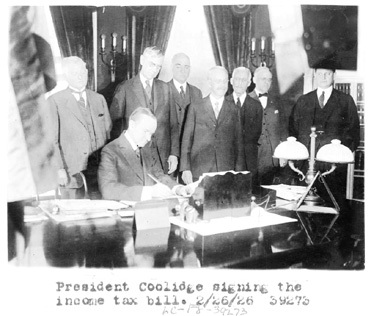 Awhile back I wrote a post correcting a claim by Fred Thompson that Calvin Coolidge’s tax cuts had been good for the economy. They weren’t. But while I was researching that post I found some other remarkable parallels between the Roaring Twenties and today, an era I like to call the Awful Aughts (as in 00s).
Awhile back I wrote a post correcting a claim by Fred Thompson that Calvin Coolidge’s tax cuts had been good for the economy. They weren’t. But while I was researching that post I found some other remarkable parallels between the Roaring Twenties and today, an era I like to call the Awful Aughts (as in 00s).
One of those parallels is with our remarkable inability to rebuild the Gulf Coast after Hurricane Katrina. During the Coolidge Administration, the United States experienced several nasty natural calamities. Among these:
On March 18, 1925, a tornado that ripped through Missouri, Illinois and Indiana killed 689 people and devastated many small towns.
On September 18, 1926, a massive hurricane hit Florida and the Gulf Coast. The Great Miami Hurricane (this was before big storms were given people names) killed 372 people and injured more than 6,000. Almost 18,000 were left homeless, and property damage was estimated to be between $80 million and $100 million. That would be something like $2 billion today. But remember there wasn’t nearly as much developed real estate in the region as there is now.
In April 1927, floods along the Mississippi River covered 4 million acres, drowning several thousand people and leaving about 600,000 people homeless. Property damage was in the neighborhood of $300 million.
On September 29, 1927, a tornado tore through St. Louis and destroyed more than a thousand homes.
And if that wasn’t enough, in September 1928 a Category 5 hurricane roared through the Caribbean and the Bahamas, then struck Florida near Palm Beach on September 16. At least 2,500 people were killed when storm surge from Lake Okeechobee breached the dike surrounding the lake, flooding hundreds of square miles. Flood waters covered the land for several weeks, and thousands were left homeless.
As awful as these disasters were, it’s more instructive for us to see how the Coolidge Administration responded. In brief, many of the devastated areas stayed devastated for a long time. This created pockets of economic stagnation in the United States, which became a drag on the entire U.S. economy. Although the Great Depression didn’t officially begin until after the stock market crash of 1929, in actuality large parts of the United States fell into depression in 1926 and 1927.
Please note that I am not saying hurricanes and floods caused the Great Depression. Rather, what we see in the response to these disasters was part of a pattern. Calvin Coolidge believed that cutting taxes and reducing government spending was about all that government needed to do to help the economy. He did cut taxes, and unlike our current “president” he cut government spending, too, and made government regulatory policies much friendlier to business. In short, he did everything the Club for Growth might have asked. But his frugality allowed large parts of the country to rot, economically speaking, and the rot eventually helped bring the whole bleeping house down.
There were other many other drags on the economy in the 1920s, such as a crisis in agriculture. For a number of reasons I won’t go into now, food prices fell and farmers were unable to make a decent living. Millions of farm families lived in abject poverty. Calvin Coolidge himself was from a poor farm family that had suffered deprivation in the 1890s, but in spite of this Coolidge was remarkably unsympathetic. He famously said, “Well, farmers never have made money. I don’t believe we can do much about it. But of course we will have to seem to be doing something.” Whereupon he embarked on a series of tepid, cosmetic “solutions” that didn’t help farmers at all. And he vetoed all bills by Congress that might have given the farmers some relief.
Note that there was little sympathy for farmers in non-farming America. Apparently city dwellers of the time thought it was hilarious that only 10 percent of farm families had running water in their homes or owned a bathtub, which were impossible luxuries to most farmers.
But let’s get back to the disasters. The 1926 hurricane unavoidably killed what had been a booming real estate market as well as tourism in Florida. (The real estate developers were so frantic to downplay the effects of the storm that they actually hindered Red Cross efforts to raise relief funds; bad publicity, you know.) Miami Beach itself was rebuilt fairly quickly with private money, but the region became economically depressed three years before the Great Depression was supposed to have begun.
I want to look in particular at the 1927 floods. Coolidge appointed his commerce secretary, Herbert Hoover, to lead disaster relief efforts. David Greenberg wrote,
Hoover threw himself into his task, but the funds he secured were insufficient. Private philanthropy simply came up short. Public debate swirled around a strong response from Washington—in both dollars and symbolism. Coolidge resisted both. Governors, senators, and mayors asked him to visit the flood zone. “Your coming would center eyes of nation and the consequent publicity would result in securing millions of dollars additional aid for sufferers,” the governor of Mississippi wired. But Coolidge demurred. He declined requests from NBC to broadcast a nationwide radio appeal, and from humorist Will Rogers to send a telegram to be read at a benefit.
To be fair, up to that time it was not considered the federal government’s job to respond to disasters. But people read newspaper accounts of the horrible suffering caused by the floods, and then they look at the federal budget surplus made possible by Coolidge’s frugality, and they put two and two together, as it were.
But Congress had adjourned, and Coolidge declined to convene a special session to pass an emergency appropriation. Only in late 1927, when Illinois’ Frank Reid, the Republican chair of the House Flood Control Committee, held public hearings was Coolidge’s hand forced. In his December 1927 State of the Union message—they were often done in December back then—he endorsed federal flood-control measures. But he insisted that local governments and property owners bear most of the costs. Coolidge’s plan also called for spending hundreds of millions dollars less than the Senate and the House bills. Deadlock ensued. Will Rogers remarked that Coolidge was going to further postpone relief legislation in “the hope that those needing relief will perhaps have conveniently died in the meantime.”
It must not be forgotten that African Americans bore a disproportionate share of the suffering. To spare New Orleans, the levee at Caernarvon, Louisiana, was dynamited. This was to divert water from the main part of New Orleans and into St. Bernard’s Parish. According to Wikipedia,
During the disaster, 700,000 people were displaced, including 330,000 African-Americans who were moved to 154 relief camps. Over 13,000 evacuees near Greenville, Mississippi were gathered from area farms and evacuated to the crest of an unbroken levee, and stranded there for days without food or clean water, while boats arrived to evacuate white women and children. Many blacks were detained and forced to labor at gunpoint during flood relief efforts.
The flood was a factor in the Great Migration of southern blacks to norther cities. It also soured African American support for the Republican Party, for a lot of reasons that can’t directly be blamed on Coolidge. But that’s huge topic I don’t want to get into now.
Anyway, David Greenburg writes that Coolidge eventually was maneuvered into signing a federal relief bill for the flooded region in May, 1928. That was thirteen months after the flood.
To explain why this is significant, I want to go back to the earlier Coolidge post, about how Coolidge’s tax cuts really didn’t provide the healthy economic growth that conservatives claim it did. I provided this quote —
Even before 1929, signs of economic trouble had become evident. Southern California and Florida experienced frenzied real-estate speculation and then spectacular busts, with banks failing, land remaining undeveloped, and mortgages foreclosed. The highly unequal distribution of income and the prolonged depression in farm regions reduced American purchasing power. Sales of new autos and household consumer goods stagnated after 1926. [Eric Foner, Give Me Liberty: An American History (Norton, 2005), p. 800]
And the stagnation in consumer goods sales was a critical factor in bringing on the Great Depression.
Coolidge did what he thought was the right thing. He cut taxes. He cut federal spending. He refused to throw money around on what we’ve come to call “entitlement” programs. He expected the farmers and the flood and storm survivors to get along without federal government help. He was a good conservative, in other words. And he and Hoover just about flushed the whole country down the toilet.
And I thought of this yesterday when I saw this article in the Washington Post by John Barry — “Our Coast to Fix — or Lose.” I urge you to read the whole article, but for now I just want to point to the ending: “The failure of Congress and the president to act aggressively to repair the coastline at the mouth of the Mississippi River could threaten the economic vitality of the nation.”
And I thought of this when I read at Bonddad Blog that consumer sales are dropping. And that our infrastructure is crumbling from neglect. And on and on.
Coolidge actually had some advantages over Bush. He paid off government debt, and he didn’t get us into a bleeping war that soaked up our bleeping resources. The long-term crisis we face now is not as much with farmers (although they’ve got their problems) as it is with our shrinking manufacturing base.
I’m just sayin’ that in the 1920s most people thought the economy was swell. The stock market went up, up, up. Lots of people made fortunes, The rich got richer. Good times.
But then, as now, income disparity grew. While the rich grew richer, most people didn’t. Many parts of the nation were suffering economically even as the 1920s roared on. Retail sales slowed, then dropped, about three years before the Great Depression swallowed everyone. I’m just sayin’.


